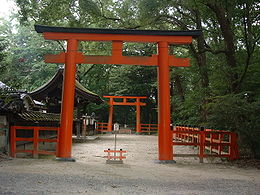Kuil Kamo

Kuil Kamo (賀茂神社code: ja is deprecated , Kamo-jinja) adalah sebuah istilah umum untuk kompleks tempat suci Shinto penting di kedua tepi Sungai Kamo di timur laut Kyoto, yang berpusat pada dua buah kuil.[1] Kedua kuil tersebut, bagian atas dan bawah, terletak di sudut ibu kota lama yang dikenal dengan nama "gerbang iblis" (鬼門code: ja is deprecated , kimon) karena kepercayaan geomansi tradisional bahwa sudut timur laut membawa kemalangan. Karena Sungai Kamo mengalir dari arah timur laut menuju kota, kedua kuil di sepanjang sungai itu dimaksudkan untuk mencegah iblis masuk ke dalam kota.[2]
Kuil Kamo mencakup apa yang sekarang berdiri sendiri namun secara tradisional dikaitkan dengan jinja atau kuil: Kuil Kamo-wakeikazuchi (賀茂別雷神社code: ja is deprecated , Kamo-wakeikazuchi jinja) di Sektor Kita Kyoto, dan Kuil Kamo-mioya (賀茂御祖神社code: ja is deprecated , Kamo-mioya jinja) di Sektor Sakyo.[1] Mereka termasuk di antara Monumen Bersejarah Kyoto Kuno yang telah ditetapkan oleh UNESCO sebagai Situs Warisan Dunia.[3]
Nama jinja menunjukkan Kami berkelompok atau para dewa yang dipuja di Kuil Kamo; dan nama tersebut mengacu pada hutan yang mengelilingi lingkungan kuil. Nama kuil tersebut juga mengacu pada penghuni awal daerah tersebut, klan Kamo, banyak di antaranya tetap tinggal di dekat kuil yang secara tradisional dilayani para leluhur mereka.[4] Kamo dihormati dengan pembangunan tempat suci Shinto ini.[5]
Catatan
- ^ a b McCullough, Helen Craig. (1994). Genji and Heike: selections from The tale of Genji and The tale of the Heike, p. 474; Iwao, Seiichi et al. (2002). Dictionnaire historique du Japon, p. 1405; Kyoto Prefectural Government Tourism Division: Kamigamo Diarsipkan 2009-08-28 di Wayback Machine..
- ^ Miyazaki, Makoto. "Lens on Japan: Defending Heiankyo from Demons," Diarsipkan 2011-03-21 di Wayback Machine. Daily Yomiuri. December 20, 2005.
- ^ Kamigamo-jinja: "Links" Diarsipkan 2009-02-21 di Wayback Machine.; Shimogamo-jinja: "Tadasu-no-mori (Forest of justice)" Diarsipkan 2019-03-19 di Wayback Machine..
- ^ Nelson, John K. (2000). Enduring Identities: The Guise of Shinto in Contemporary Japan, pp. 92-99.
- ^ Iwaso, p. 1712.
Referensi
- Ashkenazi, Michael. (2003). Handbook of Japanese mythology. Santa Barbara, California: ABC-Clio. ISBN 978-1-57607-467-1
- Benson, John. (2003). Japan. London: Dorling Kindersley. ISBN 978-0-7894-9719-2; OCLC 52965361
- Breen, John and Mark Teeuwen. (2000). Shinto in History: Ways of the Kami. Honolulu: University of Hawaii Press. ISBN 978-0-8248-2363-4
- de Bary, Theodore, Donald Keene and Yoshiko Kurata Dykstra. (1958). Sources of Japanese Tradition. New York: Columbia University Press. OCLC 220375147
- Guichard-Anguis, Sylvie and Okpyo Moon. (2009). Japanese Tourism and Travel Culture. London: Taylor & Francis. ISBN 9780415470018 ISBN 9780203886670 ISBN 0203886674; OCLC 227922678
- Hall, John Whitney, Donald Shively and William H. McCullough. (1999). The Cambridge History of Japan: Heian Japan. Cambridge: Cambridge University Press. ISBN 978-0-521-22353-9
- Nelson, John K. (2000). Enduring Identities: The Guise of Shinto in Contemporary Japan. Honolulu: University of Hawaii Press. ISBN 978-0-8248-2259-0
- Perkins, George W. (1998). The clear mirror: a chronicle of the Japanese court during the Kamakura period (1185-1333). Stanford: Stanford University Press. ISBN 978-0-8047-2953-6
- Ponsonby-Fane, Richard. (1934). Kamo-mioya Shrine. Kobe: J. L. Thompson. OCLC 6045058
- ____________. (1956). Kyoto: The Old Capital of Japan, 794-1869.[pranala nonaktif permanen] Kyoto: Ponsonby Memorial Society. OCLC 36644
- ____________. (1959). The Imperial House of Japan. Kyoto: Ponsonby Memorial Society. OCLC 194887
- ____________. (1962). Studies in Shinto and Shrines. Kyoto: Ponsonby Memorial Society. OCLC 399449
- ____________. (1963). Vicissitudes of Shinto. Kyoto: Ponsonby Memorial Society. OCLC 36655
- ____________. (1964). Visiting Famous Shrines in Japan. Kyoto: Ponsonby-Fane Memorial Society. OCLC 1030156
- Terry, Thomas Philip. (1914). Terry's Japanese empire: including Korea and Formosa, with chapters on Manchuria, the Trans-Siberian railway, and the chief ocean routes to Japan; a guidebook for travelers. New York: Houghton Mifflin. OCLC 2832259
- Wheeler, Post. (1976). The sacred scriptures of the Japanese: with all authoritative variants, chronologically arranged, setting forth the narrative of the creation of the cosmos, the divine descent of the sky-ancestor of the imperial house and the lineage of the earthly emperors. Westport, Connecticut: Greenwood Press. ISBN 978-0-8371-8393-0; OCLC 263528152
Pranala luar

- Kamigamo Shrine website Diarsipkan 2017-10-23 di Wayback Machine.
- Shimogamo Shrine website Diarsipkan 2014-04-25 di Wayback Machine.
Koordinat: 35°03′37″N 135°45′10″E / 35.06028°N 135.75278°E / 35.06028; 135.75278









